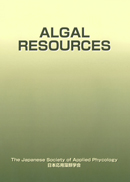Morphological studies of the
Porphyra akasakae Miura (Rhodophyta, Bangiales) collected on December 14, 2005 were reported from Iwaizaki, Miyagi Prefecture, northern Pacific coasts of Honshu, Japan. It has been considered that
P. angusta sensu Kurogi and
P. angusta f.
sanrikuensis Kurogi were synonyms of
Porphyra akasakae Miura. Zygotospores and conchospores were cultured at 10-30 ℃ and 60μmol m
-2s
-1 under 14L: 10D and 10L:14D. Conchospores germinated and grew to normal shape blades at 10-20℃. However, the germlings did not grow to normal size at 25℃. The maturation of male and female blades occurred at 20℃, and the spermatia in the male blade and zygotospores in the female blades were produced after 10 - 12 weeks in culture, and mother cells divided into 128 (a/4, b/4, c/8) sprematia and 8 (a/2, b/2, c/2) zygotospores, respectively. The conchocelis grew rapidly at 25℃ and 14L:10D, and the conchospores were released 3 weeks after zygotospore germination. This species has been known to have dioecious or monoecious blade, however, in this culture, blades were mostly dioecious, and about 7 % of blades in cultures were monoecious, and spermatangia or zygotospores produced and divided at the upper or lower portion of the blade. The life cycle of this species was different from the previous reports and revealed to be
P. dentata-type.
View full abstract
